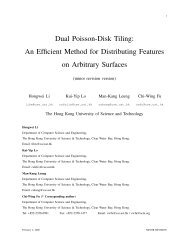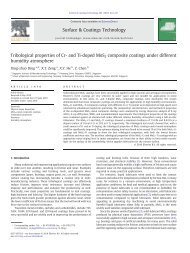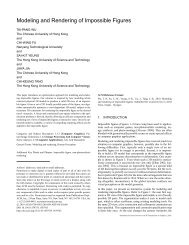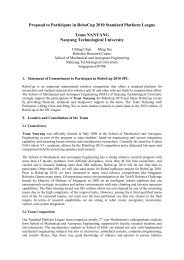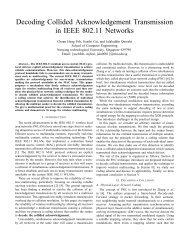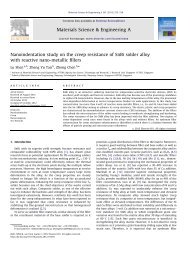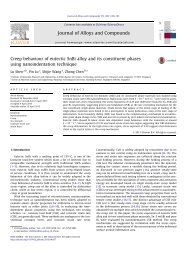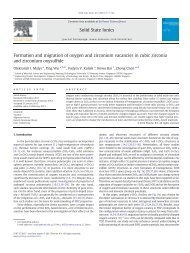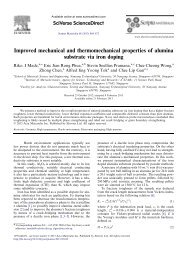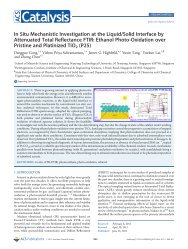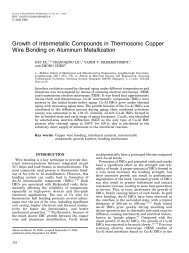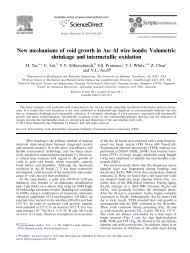Elasticity modulus, hardness and fracture toughness of Ni3Sn4 ...
Elasticity modulus, hardness and fracture toughness of Ni3Sn4 ...
Elasticity modulus, hardness and fracture toughness of Ni3Sn4 ...
Create successful ePaper yourself
Turn your PDF publications into a flip-book with our unique Google optimized e-Paper software.
Fig. 2. SEM images showing the film cracking patterns after the <strong>fracture</strong> <strong>toughness</strong><br />
test. Grains <strong>of</strong> about 100 nm are clearly visible from these pictures. Specimens<br />
are annealed at (a) 100, (b) 150 <strong>and</strong> (c) 200 ◦ C for 24 h.<br />
Z. Chen et al. / Materials Science <strong>and</strong> Engineering A 423 (2006) 107–110 109<br />
ing, the residual stress was very small. Significant tensile stress<br />
has developed after 150 <strong>and</strong> 200 ◦ C annealing, most likely<br />
caused by densification <strong>of</strong> the films. Since the co-deposition is<br />
carried out without substrate heating, the mobility <strong>of</strong> the adatoms<br />
are relatively low, <strong>and</strong> there will inevitably exist some internal<br />
defects, such as vacancies <strong>and</strong> interstitial voids, etc. During<br />
annealing the elimination <strong>of</strong> these defects densifies the film.<br />
However the film is constrained by the substrate so that it cannot<br />
densify by shrinking. As a result, tensile stress in the film<br />
will be induced [27]. Since such a process is thermally activated,<br />
stress can only build up when the temperature is high<br />
enough.<br />
The indentation <strong>hardness</strong> decreased steadily with the increase<br />
<strong>of</strong> annealing temperatures. This was believed to be related to<br />
the tensile stress in the film. Indentation measures the resistance<br />
to compressive intrusion by the indenter tip. Tensile stress<br />
in the film reduces the penetration resistance to the indenter,<br />
<strong>and</strong> thus reduces the measured <strong>hardness</strong>. The elasticity <strong>modulus</strong><br />
fell slightly with the residual stress but it did not seem<br />
to follow the steady trend as the <strong>hardness</strong> did. Our reported<br />
<strong>modulus</strong> at stress-free state (100 ◦ C annealing) agreed very well<br />
with the reported value <strong>of</strong> 133.3 GPa by Fields et al. [2] but<br />
was higher than 118.4 GPa reported by Ghosh [4]. In Ghosh’s<br />
work, the average grain size was 32 m <strong>and</strong> the indentation<br />
was made inside a grain. Therefore the reported value in his<br />
work was an average <strong>of</strong> values from many single grains with<br />
unknown crystallographic orientations. While in our current<br />
work, the grain size was small so that the indentation likely<br />
reflected contribution from multiple grains. We suppose that<br />
the difference could be due to the difference in crystallographic<br />
orientation.<br />
3.3. Fracture <strong>toughness</strong><br />
The <strong>fracture</strong> <strong>toughness</strong> measured is reported in Table 1 with<br />
its st<strong>and</strong>ard deviation. Since our measured elasticity <strong>modulus</strong><br />
was very close to one by Fields et al. [2], the <strong>modulus</strong><br />
(133.3 GPa) <strong>and</strong> Poisson’s ratio (0.33) recommended by Fields<br />
et al. were used in our calculation <strong>of</strong> <strong>fracture</strong> <strong>toughness</strong>. Residual<br />
stress was superimposed on the stress induced by the buckling<br />
test, therefore the influence from the residual stress was well<br />
accounted for. The cracking patterns in Fig. 2 show that the<br />
<strong>fracture</strong> was mainly intergranular, which is similar to the thin<br />
film cracking in Cu–Sn IMCs [10]. It is interesting to note that<br />
the cracks remained open after the release <strong>of</strong> the loading for<br />
the 150 <strong>and</strong> 200 ◦ C annealed specimens. The gap could not be<br />
caused by residual plastic deformation since the film <strong>and</strong> the<br />
substrate remained elastic during the <strong>fracture</strong> test. We believe<br />
it is to due to the release <strong>of</strong> residual tensile stress <strong>of</strong> the film<br />
at the vicinity <strong>of</strong> crack. This view is supported by comparing<br />
Fig. 2(a)–(c): the gap was wider with the 200 ◦ C, which has the<br />
highest residual tensile stress.<br />
There was a considerable increase in <strong>fracture</strong> <strong>toughness</strong> with<br />
annealing temperature from 2.11 ± 0.15 MPa m 1/2 for 100 ◦ C<br />
annealing to 5.75 ± 0.25 MPa m 1/2 for 200 ◦ C annealing. The<br />
scatter in our experiment was smaller than what one would<br />
expect from a conventional <strong>fracture</strong> <strong>of</strong> bulk, brittle materials.



